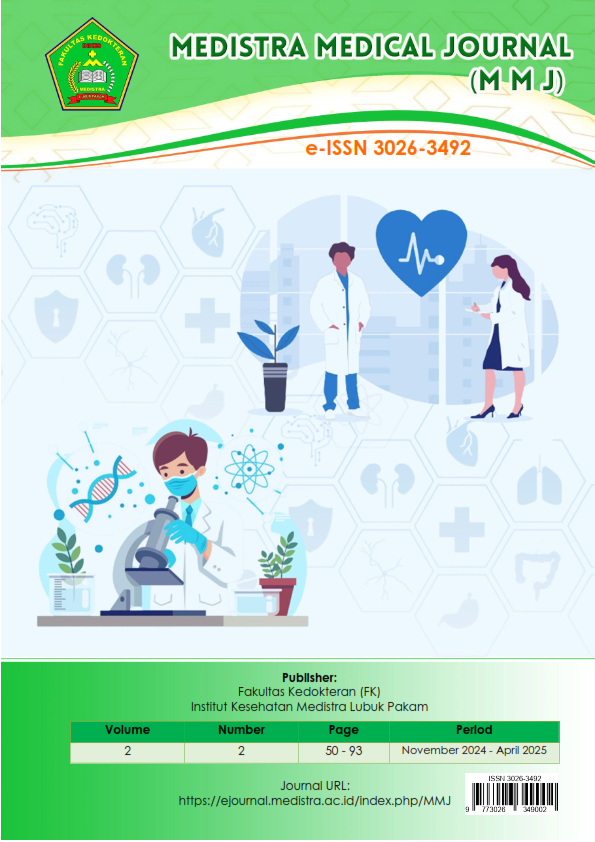Integration Model of Primary and Referral Services in Catastrophic Emergency Management at Grandmed General Hospital Lubuk Pakam in 2023
DOI:
https://doi.org/10.35451/xa3xhf87Keywords:
Service integration; referral system; emergency care; catastrophic disaster; hospital.Abstract
Background: Catastrophic emergencies require effective integration between primary care and referral services to accelerate patient management. However, the implementation of the referral system in Indonesia still faces challenges, including limited infrastructure, human resources, and inter-facility coordination. Objective: This study aimed to analyze and develop an integrated model of primary care and referral services in the management of catastrophic emergencies at RSU Grandmed Lubuk Pakam in 2023. Methods: A mixed-method approach with a sequential explanatory design was applied. Quantitative data were collected through questionnaires distributed to 80 healthcare workers involved in the referral process, while qualitative data were obtained from in-depth interviews and focus group discussions with 15 key informants. Quantitative data were analyzed using descriptive and inferential statistics, whereas qualitative data were analyzed thematically. Results: Findings revealed that ambulance availability was considered adequate (70%), while emergency equipment (55%) and digital communication systems (40%) remained limited. Most healthcare workers had received emergency training (62.5%), yet only 48% felt confident in referral coordination. The referral process was relatively clear (60%), but inter-facility coordination (45%) and patient data integration (35%) were suboptimal. Qualitative analysis highlighted four main issues: weak integrated communication, limited trained human resources, the need for digitalization of the referral system, and insufficient cross-sector coordination. Conclusion: This study proposes an integration model consisting of four key components: (1) strengthening infrastructure, (2) enhancing healthcare workers’ capacity through training and simulations, (3) implementing an application-based referral information system, and (4) reinforcing cross-sector coordination. This model is expected to improve the effectiveness of catastrophic emergency management at RSU Grandmed Lubuk Pakam and serve as a reference for other hospitals in Indonesia
References
[1] World Health Organization. (2022). Emergency and disaster risk management for health. WHO.
[2] Kementerian Kesehatan RI. (2021). Pedoman Sistem Rujukan Pelayanan Kesehatan. Jakarta: Kemenkes RI.
[3] Putri, A., Santoso, B., & Rahayu, D. (2021). Analisis hambatan sistem rujukan kegawatdaruratan di Indonesia. Jurnal Manajemen Pelayanan Kesehatan, 24(2), 115–123.
[4] Nugraha, H., Sari, R., & Lubis, Z. (2022). Evaluasi implementasi sistem rujukan pasien gawat darurat di rumah sakit daerah. Jurnal Administrasi Kesehatan Indonesia, 10(1), 45–54.
[5] Dinas Kesehatan Sumatera Utara. (2023). Profil Kesehatan Provinsi Sumatera Utara Tahun 2022. Medan: Dinkes Sumut.
[6] Rahmawati, N., & Wulandari, E. (2020). Pengaruh integrasi layanan primer dan rujukan terhadap kualitas penanganan kasus gawat darurat. Jurnal Keperawatan Indonesia, 23(3), 179–187.
[7] Dewi, F., Hartono, A., & Pratama, R. (2021). Sistem rujukan terintegrasi pada pelayanan kegawatdaruratan: Studi kasus di rumah sakit tipe B. Jurnal Administrasi Rumah Sakit Indonesia, 7(2), 88–96.
[8] Nugraha, H., Sari, R., & Lubis, Z. (2022). Evaluasi implementasi sistem rujukan pasien gawat darurat di rumah sakit daerah. Jurnal Administrasi Kesehatan Indonesia, 10(1), 45–54.
Downloads
Published
Issue
Section
License
Copyright (c) 2025 Wenny Dwi Chandra

This work is licensed under a Creative Commons Attribution 4.0 International License.
Copyright in each article is the property of the Author.
















